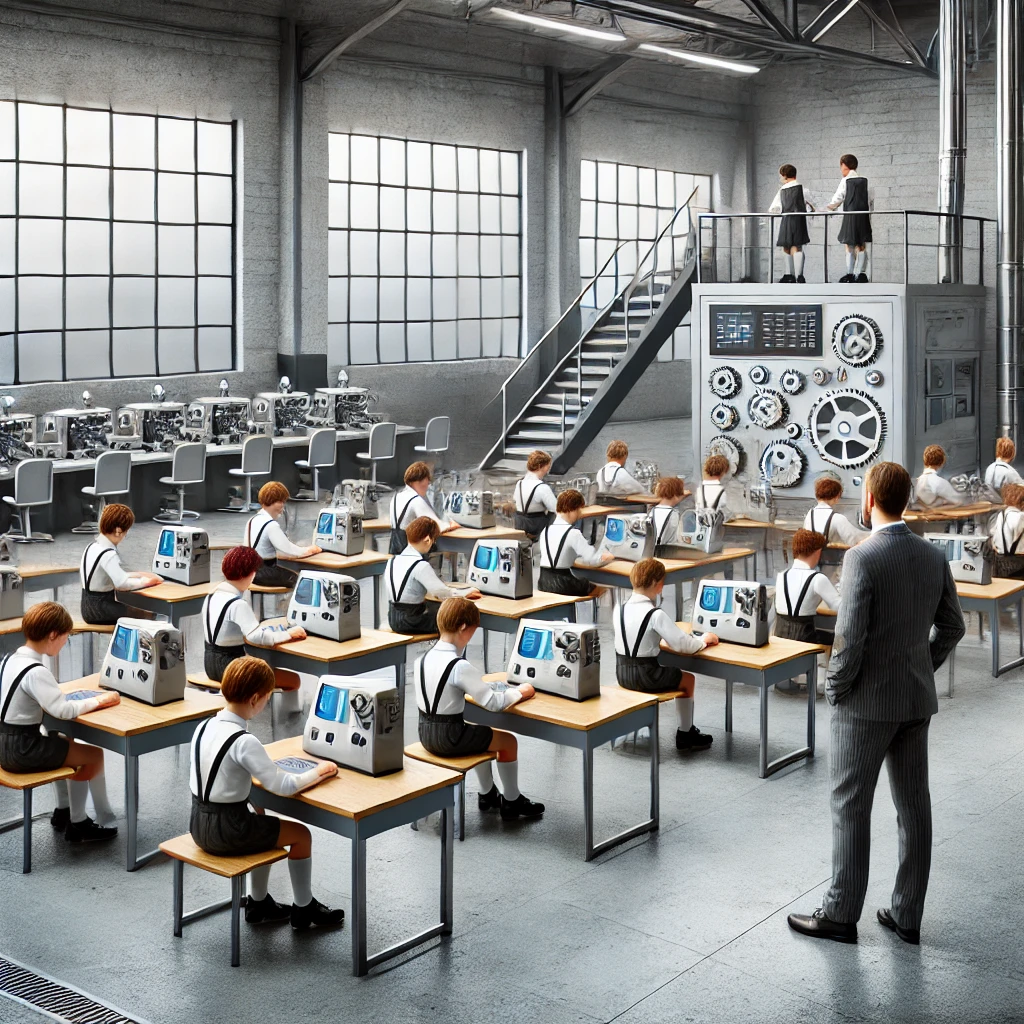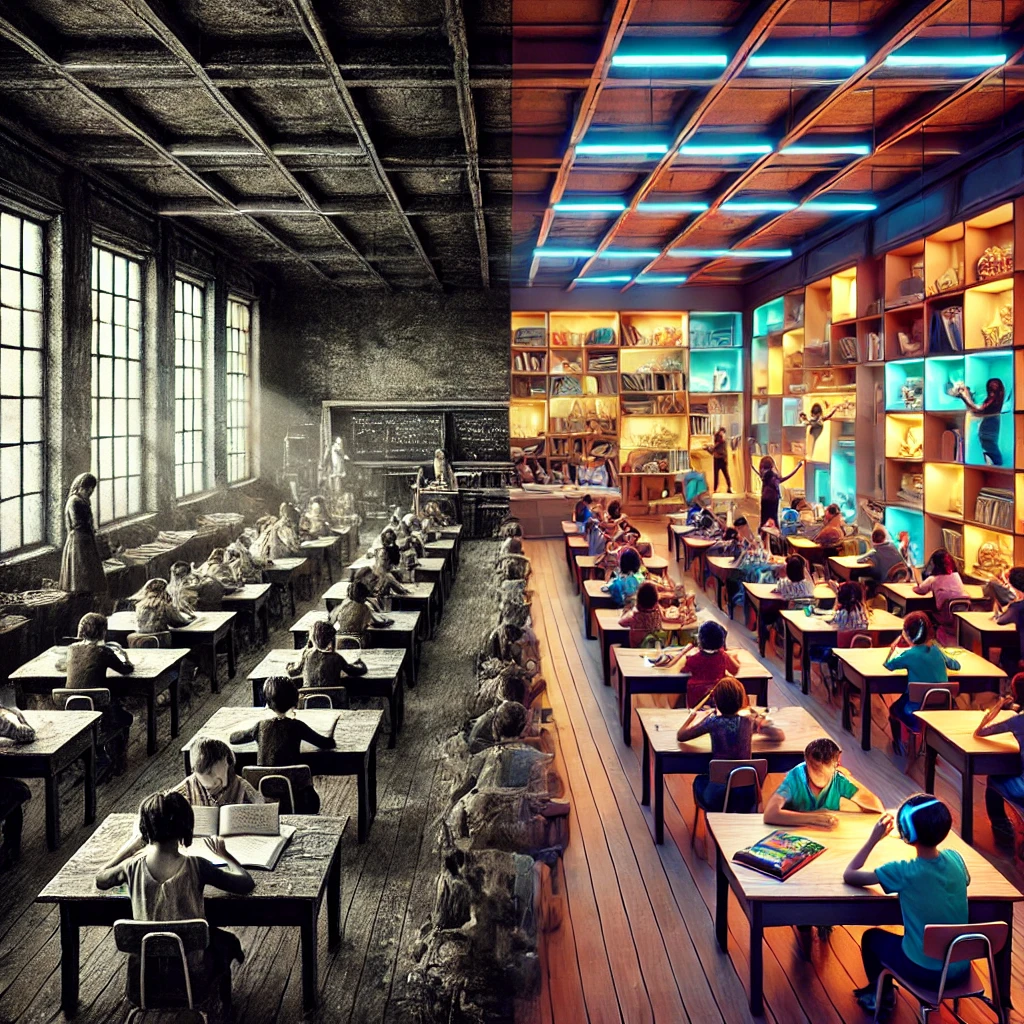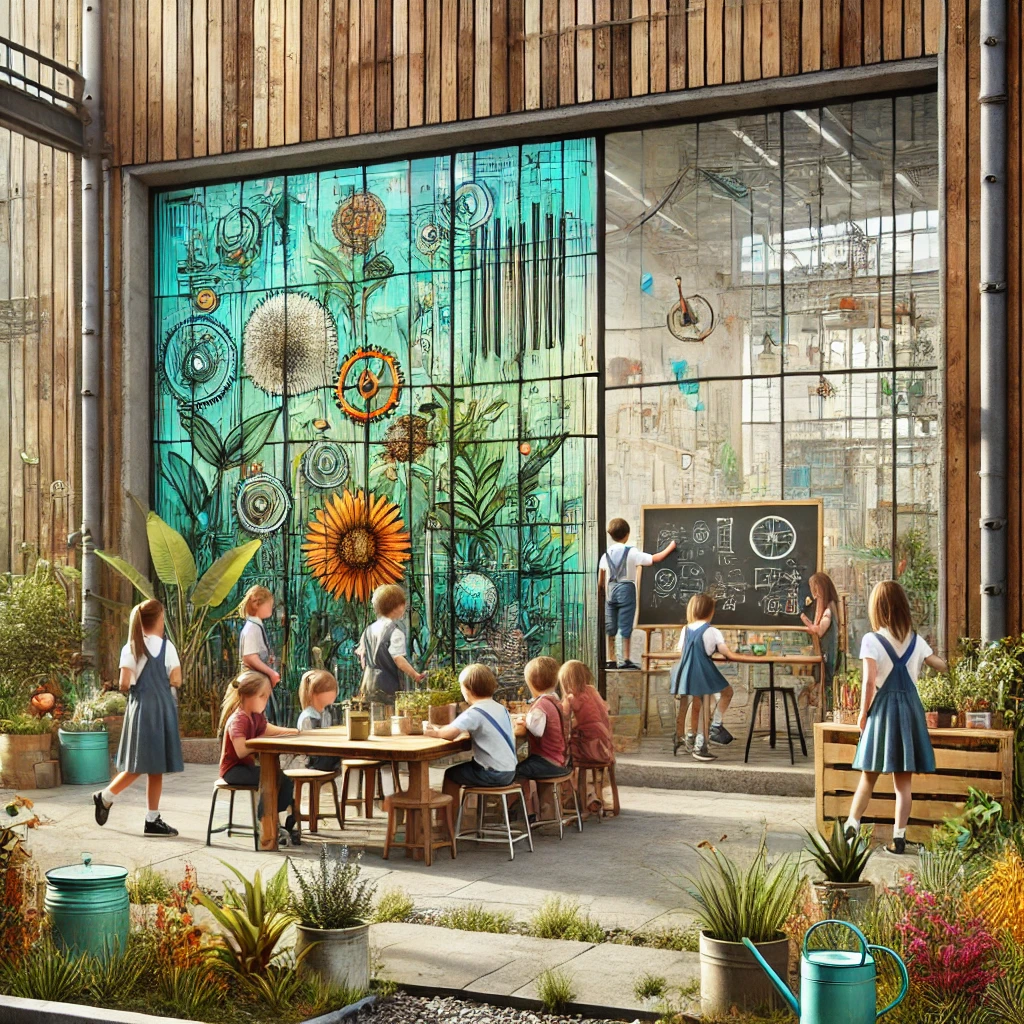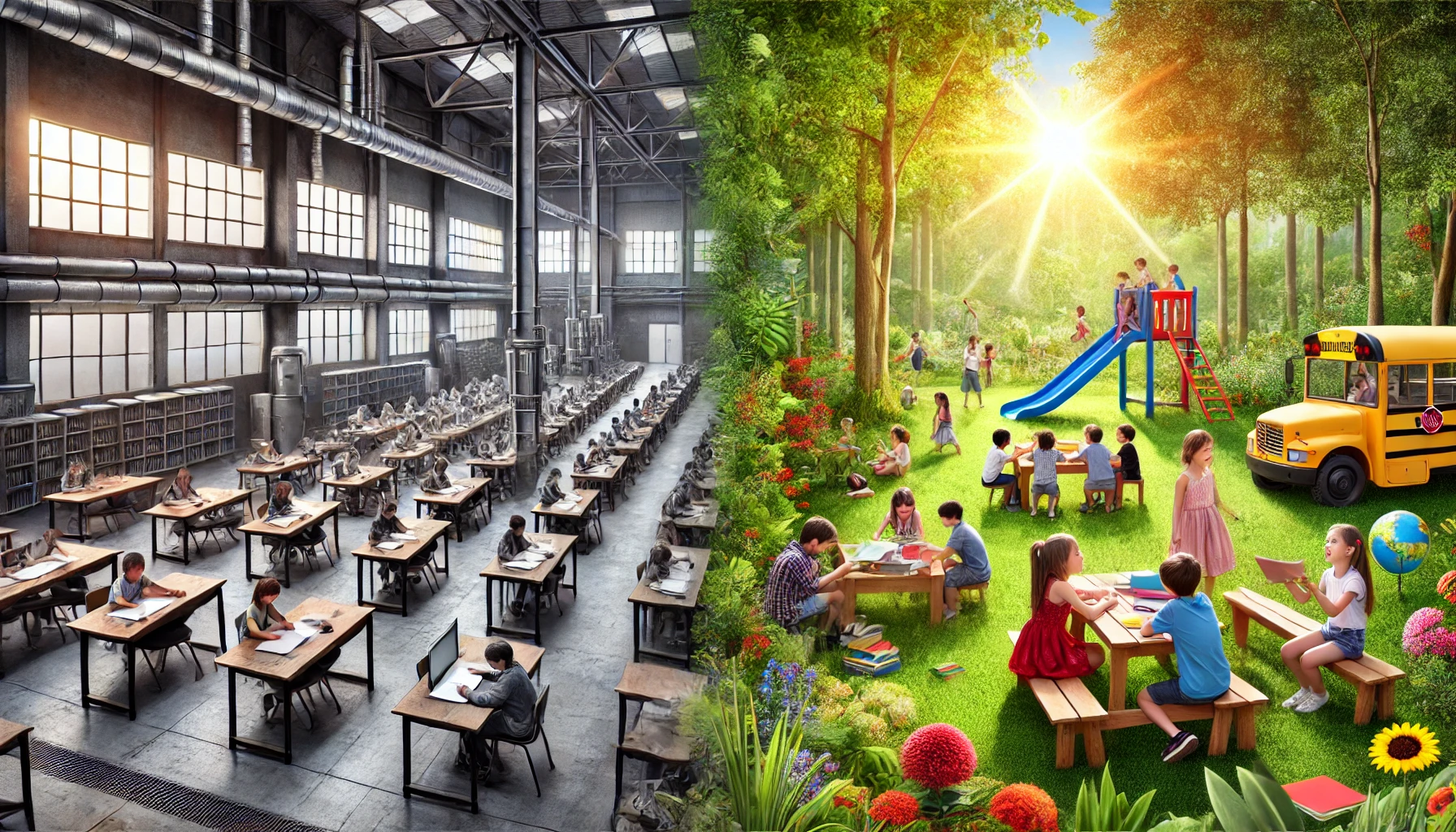The Elephant in the Classroom
Let’s get one thing straight: the U.S. education system is antique. It’s the educational equivalent of using a flip phone in the age of smartphones. Built on the 18th-century Prussian model, this system wasn’t designed to create thinkers, creators, or leaders. Instead, it was tailored to churn out obedient factory workers who’d clock in, follow instructions, and never question authority.
Back in the late 1700s, this approach made sense. The Industrial Revolution was on the horizon, and the world needed disciplined soldiers, clerks, and factory hands to keep society humming. Fast-forward to today, and the demands of the modern world couldn’t be more different. We’re building quantum computers, exploring AI, and solving problems that didn’t even exist a century ago. Yet, our schools still function like assembly lines.
Instead of nurturing curiosity and innovation, the system drills students on how to memorize facts, follow rigid rules, and excel at standardized tests. These tests often prioritize rote memorization over real understanding. Sure, you can ace a test on the Pythagorean theorem, but can you apply it to design a bridge or solve a real-world problem? That’s the gap we’re grappling with.
The most frustrating part? The tools to change this are within reach. Technology has revolutionized communication, transportation, and even how we order lunch, but education remains stuck in a 225-year-old rut. While the rest of the world zooms ahead, the U.S. school system trudges along with its horse-and-buggy methods, creating students who are more prepared for 19th-century factories than 21st-century careers.
So, why are we clinging to a system that’s nearly 225 years old?
The answer isn’t simple. Changing an entrenched system requires a cultural and political shift. It also demands that we rethink what we value in education. Do we prioritize test scores or critical thinking? Compliance or creativity? Memorization or mastery? These aren’t just questions for policymakers—they’re questions for every parent, teacher, and student caught in the grind of this outdated model.
To make matters worse, the Prussian model subtly discourages rebellion against the status quo. By design, it creates citizens who comply, not those who challenge the system. This may have been ideal in 18th-century Prussia, but in a modern world driven by innovation, it’s a glaring disadvantage.
If we want the U.S. to remain competitive globally, we need to let go of this relic of the past. The world is moving at the speed of light, and our education system needs to catch up—or risk being left in the dust.
The Prussian Model: A Factory of Compliance
The Prussian education model wasn’t built for thinkers—it was built for doers. Its design was unapologetically utilitarian, intended to mold obedient citizens who could seamlessly integrate into the demands of the state. The goal? Produce a disciplined workforce to fill roles as soldiers, clerks, and factory laborers—people who followed orders, respected authority, and didn’t ask too many questions.
In the 18th and 19th centuries, this system worked. Industrialization was the backbone of progress, and nations needed cogs in the machine, not creative disruptors. Back then, routine was king, and compliance was the foundation of societal order. Schools mirrored the assembly lines that defined industry—structured, predictable, and geared for efficiency over individuality.
But fast-forward to today, and the cracks in this model are glaring. The 21st century isn’t about compliance; it’s about creativity, innovation, and adaptability. The world’s most successful businesses and industries thrive on disruption, bold ideas, and the ability to pivot in the face of change. Yet, the U.S. education system clings to a framework that hasn’t evolved in over two centuries.

From the Classroom to the Bubble Sheet
Instead of fostering curiosity and critical thinking, the Prussian model emphasizes rote memorization and rigid discipline. The system trains students to absorb information, regurgitate it on demand, and then promptly forget it once the test is over. According to The Washington Post, the average U.S. student endures a staggering 112 standardized tests between kindergarten and 12th grade. That’s not an education; that’s a factory production line churning out test-takers.
The problem with standardized testing isn’t just the sheer volume—it’s the focus. These tests measure how well students can memorize facts, decipher multiple-choice questions, and follow a formula. While this may showcase their ability to “guess the right bubble,” it doesn’t prepare them for solving complex problems, thinking critically, or navigating the gray areas of real life.
Worse still, this test-centric culture squeezes out creativity and exploration. When schools are evaluated on test scores, teaching to the test becomes the norm. Subjects like art, music, and even science experiments—anything that doesn’t directly contribute to standardized metrics—are often sidelined. The result? Students graduate knowing how to pass exams but lacking the skills to innovate, adapt, or excel in a dynamic world.
What Happens When Compliance Takes Over?
The long-term consequences of this system are alarming. By prioritizing conformity over creativity, the Prussian model creates graduates who are well-prepared to follow instructions but poorly equipped to lead. This is why many of the most innovative companies in the U.S. are led by individuals who were educated outside the American system—or by those who managed to break free from its constraints.
Take Silicon Valley, for example. The CEOs of top tech firms are disproportionately immigrants or the products of alternative educational systems. Why? Because they were taught to think critically, question norms, and approach problems creatively. Meanwhile, the Prussian model in the U.S. produces students who are great at filling in the blanks but often struggle to think outside the box.
The Disconnect Between Education and Reality
Today’s economy is powered by innovation, collaboration, and technology. Employers want problem-solvers, communicators, and thinkers—not workers who simply do as they’re told. Yet, our schools are stuck in a time warp, producing graduates better suited for 19th-century factories than 21st-century boardrooms.
If we’re serious about preparing students for the future, we need to dismantle the assembly line. Education should be a launchpad for creativity, a breeding ground for ideas, and a place where students learn to adapt and thrive in an ever-changing world. But to achieve that, we must first let go of the outdated Prussian model and embrace a system that values innovation over compliance.
Because let’s face it—guessing the right bubble might win you points on a standardized test, but it won’t help you build the next groundbreaking app, cure a disease, or solve the mysteries of the universe. It’s time to rethink what education is really for.
The Swedish Model: Creativity Meets Critical Thinking
Across the Atlantic, Sweden is nailing the education game. Consistently ranked at the top of U.S. News’ “most well-developed public education systems,” Sweden has cracked the code on how to educate kids for the future. While other countries struggle with outdated models and test-heavy curriculums, Sweden has shifted the focus to creativity, problem-solving, and independent thought.
What sets Sweden apart is its bold commitment to nurturing critical thinkers rather than compliant test-takers. Swedish schools encourage students to question everything, including their teachers. This isn’t a rebellious free-for-all—it’s a deliberate strategy to foster curiosity and intellectual growth. By empowering students to challenge conventional wisdom, Sweden equips them with the tools to innovate and adapt in a rapidly changing world.

Fewer Tests, More Thinking
Let’s talk about testing—or, in Sweden’s case, the lack of it. Unlike the United States, where standardized tests are a cornerstone of the educational experience (112 tests from kindergarten to 12th grade!), Swedish students only take national exams three times during their entire school journey.
These tests happen in years 3, 6, and 9 and focus on core subjects like math, English, and Swedish. That’s it. By minimizing the emphasis on standardized assessments, Sweden ensures that students spend less time cramming for exams and more time learning how to think critically, solve problems, and explore new ideas.
The result? Swedish students don’t just memorize facts—they understand concepts. They’re encouraged to connect the dots, apply their knowledge, and think on their feet. This approach not only enhances learning but also prepares students to tackle real-world challenges with confidence and creativity.
Education Without Financial Barriers
Another standout feature of the Swedish education system is its cost—or lack thereof. In Sweden, education is completely free for citizens. From preschool to university, students don’t pay tuition fees. This removes a significant barrier to access and ensures that every child, regardless of their family’s financial situation, has the opportunity to succeed.
Contrast this with the United States, where the cost of higher education often saddles students with crippling debt. By eliminating financial stress, Sweden allows students to focus on their studies and pursue their passions without worrying about how they’ll pay for it.
Encouraging Critical Thinking
In Swedish classrooms, debates and discussions are not just tolerated—they’re encouraged. Students are taught to question assumptions, challenge ideas, and express their opinions. This isn’t about being disruptive; it’s about developing a mindset that values curiosity and intellectual engagement.
Teachers in Sweden act as guides rather than authoritarian figures. They create an environment where students feel comfortable sharing their thoughts, exploring different perspectives, and engaging in meaningful dialogue. This approach not only fosters critical thinking but also builds confidence and communication skills.
Why Sweden Stands Out
Here’s a breakdown of what makes Sweden’s education system a model for the future:
- Free Education: From preschool to college, tuition fees are non-existent. Education is treated as a public good, not a privilege.
- Minimal Testing: National exams occur just three times during a student’s academic career, allowing for more in-depth and meaningful learning.
- Focus on Core Competencies: Testing is limited to essential subjects like math, English, and Swedish, ensuring a balanced curriculum.
- Critical Thinking Emphasis: Debates and questioning are part of everyday learning, fostering intellectual curiosity and innovation.
- Innovation-Driven Curriculum: Creativity and independent thought are central, preparing students to excel in dynamic, fast-changing industries.
The Bigger Picture
Sweden’s education system proves that there’s a better way. By prioritizing creativity, critical thinking, and equal access, they’ve created an environment where students thrive. Imagine an education system where kids aren’t burned out by endless exams, families aren’t drowning in tuition debt, and learning is actually engaging.
The Swedish model isn’t just about better schools—it’s about building a better society. Their approach produces individuals who are not only well-educated but also innovative, adaptable, and ready to tackle the challenges of the future.
For countries like the United States, the takeaway is clear: stop treating students like cogs in a machine and start treating education like the transformative force it should be. Sweden has shown us what’s possible. The question is: are we ready to follow their lead?

Why the U.S. System Is Falling Behind
It’s ironic, isn’t it? The U.S. ranks third globally in overall country metrics—an economic and cultural juggernaut—yet its education system limps in at 12th place. With a GDP of $27.4 trillion, the resources exist to create an education system that could rival the world’s best. But instead of progress, we’re left grappling with overcrowded classrooms, underpaid teachers, and curriculums that seem more fitting for a bygone era.
The cracks in the system run deep. Overcrowding means students aren’t getting the individualized attention they need to thrive. Teachers, many of whom are passionate and capable, are often burned out due to low pay and lack of resources. Meanwhile, outdated curriculums fail to prepare students for modern challenges, leaving them behind in an increasingly competitive global market.
Even worse, a system bogged down by bureaucracy and resistance to change makes innovation feel like a distant dream. The result? An education system that churns out graduates who are book-smart but ill-prepared to tackle the complexities of a world driven by technology, creativity, and adaptability.
Homeschooling: The DIY Alternative
For parents growing increasingly frustrated with the shortcomings of traditional education, homeschooling offers a refreshing and empowering solution. It’s more than just an escape from the confines of an outdated system—it’s an opportunity to redefine learning on your terms. And the evidence backs it up: children who are homeschooled often outperform their peers academically and socially, with studies highlighting improved test scores, better critical thinking skills, and even stronger family bonds.
Homeschooling puts the power back in the hands of parents, allowing them to tailor their child’s education to match their unique needs, passions, and learning styles. No longer limited by rigid curriculums or overcrowded classrooms, homeschooling creates an environment where children can thrive.
Why Homeschooling Works
The appeal of homeschooling lies in its flexibility and adaptability. Whether your child dreams of programming robots, exploring marine biology, or perfecting their art skills, homeschooling allows them to dive deep into their interests in ways traditional schools can’t accommodate. This personalized approach can transform education from a mundane task into an exciting adventure, here are some of the key benefits of homeschooling:
- Flexibility to Explore Passions:
Traditional schools often operate under a one-size-fits-all model, where every student must progress at the same pace, regardless of individual interests or abilities. Homeschooling flips this on its head. Parents can create a curriculum tailored to their child’s strengths and interests, allowing them to flourish in areas they’re passionate about.- Love dinosaurs? Build science lessons around paleontology.
- Obsessed with space? Dive into astronomy and physics.
- A budding chef? Turn the kitchen into a classroom for math, chemistry, and creativity.
- Hands-On, Engaged Learning:
Homeschooling encourages children to experience education beyond the confines of textbooks. Outdoor adventures, science experiments, art projects, and hands-on activities bring lessons to life. Instead of passively absorbing information, kids become active participants in their learning journey.
Imagine learning biology by exploring local ecosystems, or math by baking a cake and calculating proportions. These experiences make education practical, enjoyable, and memorable. - Reduced Stress and Anxiety:
Overcrowded classrooms, bullying, and the relentless grind of standardized testing can take a toll on a child’s mental health. Homeschooling removes these stressors, creating a safe and supportive environment where children can learn at their own pace.
The absence of rigid schedules and high-pressure testing allows for a more relaxed and positive learning atmosphere, reducing burnout and fostering a love for learning.

The Big Picture
Homeschooling isn’t just an alternative to traditional education—it’s a way to rethink what learning can look like. It empowers parents to create an environment where their children can thrive academically, socially, and emotionally.
But while homeschooling offers unparalleled flexibility and customization, it’s not for everyone. It requires time, effort, and commitment. For parents willing to take on the challenge, the rewards can be extraordinary.
Whether you’re considering homeschooling as a temporary solution or a long-term commitment, the goal is the same: to provide your child with an education that inspires curiosity, fosters critical thinking, and prepares them for a bright and dynamic future. And in today’s world, that’s a lesson worth learning.
Woke Curriculums and the “Unschooling” Debate
In the push to reform education, ideological challenges have emerged, further complicating an already delicate issue. At one end of the spectrum, “woke” curriculums have infiltrated schools, emphasizing hyper-politicized content. While the intention may be to broaden perspectives and encourage social awareness, the execution often distracts from foundational subjects like math, science, and literacy—areas critical for equipping students with the skills they need to succeed in the real world.
On the other end, the “unschooling” movement takes a radically different approach, rejecting formal education altogether. Proponents argue that children are natural learners who will pursue knowledge on their own terms. But in today’s world, saturated with screens, social media, and endless entertainment, the absence of structure can leave kids floundering, unprepared for the challenges of adulthood.
These extremes—hyper-politicized curriculums and a complete lack of formal education—both highlight a core truth: education requires balance.
The Woke Curriculum: Progress or Distraction?
The rise of woke curriculums has sparked heated debates among parents, educators, and policymakers. Advocates argue that these curriculums help students understand systemic injustices, embrace diversity, and think critically about society. However, critics contend that they often veer into activism at the expense of academic rigor.
Take, for example, schools where more time is spent discussing ideological topics than mastering basic skills like reading comprehension or algebra. While social awareness is important, it shouldn’t overshadow the foundational knowledge students need to succeed in higher education or the workforce.
The risk here is clear: when schools prioritize politics over academics, students may graduate without the tools to think critically, solve problems, or compete in a global economy. Balancing the inclusion of diverse perspectives with a focus on core subjects is essential to prepare students for the complexities of the modern world.
The “Unschooling” Movement: Freedom or Chaos?
At the opposite end of the debate lies the “unschooling” movement, a philosophy that dismisses traditional schooling and structured curriculums altogether. Unschooling relies on the idea that children are naturally curious and will learn what they need through exploration and self-directed activities.
In theory, this approach sounds idyllic—a world where kids learn through play, curiosity, and real-world experiences. But in practice, it often falls short, particularly in today’s screen-dominated world.
Without guidance, many children struggle to focus on meaningful learning. The allure of video games, YouTube, and social media can easily overshadow the pursuit of knowledge. Furthermore, unschooling can leave gaps in essential skills like math, writing, and scientific reasoning—areas that aren’t always fun but are undeniably necessary.
The Need for Balance
Both woke curriculums and unschooling philosophies fail to address the fundamental purpose of education: preparing children for a successful, fulfilling, and well-rounded life. While it’s important to encourage students to explore diverse perspectives and pursue their passions, this must be done within a framework of structure and accountability.
What Balanced Education Looks Like:
- Foundational Knowledge:
Students need a solid grounding in core subjects like math, science, and literacy. These skills are the building blocks of critical thinking and problem-solving, no matter what path a student takes. - Critical Thinking and Diversity:
Education should encourage students to think critically about the world around them, exposing them to diverse perspectives without forcing ideological conformity. Debate and discussion should be tools for growth, not platforms for indoctrination. - Freedom Within Structure:
A balanced system allows students the freedom to explore their interests while maintaining a structured curriculum that ensures essential learning isn’t neglected. For example, a student passionate about art could integrate their love for creativity into projects in history, science, or technology. - Preparation for Adulthood:
Schools should focus on equipping students with real-world skills like financial literacy, communication, and digital competence. These are essential for navigating the complexities of modern life, regardless of ideological leanings.
Moving Forward
The future of education shouldn’t be about choosing between extremes—it should be about finding a middle ground that works for all students. Hyper-politicized content shouldn’t drown out academic fundamentals, and unstructured learning shouldn’t leave children without the tools they need to succeed.
Parents, educators, and policymakers must collaborate to build an education system that combines structure with creativity, foundational knowledge with critical thinking, and guidance with freedom. The goal isn’t just to teach children what to think—it’s to teach them how to think.
In the end, balanced education is the key to raising a generation of informed, capable, and innovative individuals who can navigate an increasingly complex and interconnected world.
Sweden’s education system proves that change is possible. It’s not a utopia—it’s a blueprint. By investing in creativity, reducing the obsession with standardized testing, and promoting equal access to quality education, Sweden has created an environment where students thrive. If they can do it, so can we.

Homeschooling: A Practical Stopgap
Until the system catches up, homeschooling may be the best option for families seeking an alternative to the “factory model” of education. With the flexibility to tailor learning to each child’s unique needs and the ability to incorporate creativity, critical thinking, and real-world skills, homeschooling offers a viable path forward.
To make the most of homeschooling, parents can draw inspiration from Sweden’s approach:
- Prioritize critical thinking: Encourage children to ask questions, debate ideas, and explore different perspectives.
- Incorporate creativity: Use hands-on projects, outdoor learning, and interdisciplinary activities to make lessons engaging and memorable.
- Focus on balance: Provide structure and foundational knowledge while allowing freedom for exploration and passion-driven learning.
While homeschooling isn’t a perfect solution for every family, it exemplifies what education could be—dynamic, personalized, and empowering.
A Vision for Tomorrow
The future of education doesn’t have to look like the past, but meaningful reform will take time—time that our children can’t afford to lose. Until the public education system undergoes a complete transformation, homeschooling stands as the only viable solution for families seeking to give their children an education that truly prepares them for the challenges of the modern world.
Imagine an education system where students aren’t just taught to memorize facts but to innovate boldly; where creativity and critical thinking are valued far more than test scores; and where teachers are empowered, supported, and equipped to inspire greatness. While this vision is attainable, it demands systemic change that dismantles the outdated factory model of schooling.
Until such reforms become a reality, homeschooling provides the flexibility, personalization, and focus that the current public system lacks. It allows parents to nurture curiosity, foster critical thinking, and cultivate a lifelong love of learning without the constraints of standardized tests or overcrowded classrooms. Homeschooling is not just an alternative; it is the best available solution to ensure children can thrive in a world driven by innovation, technology, and global collaboration.
The U.S. has always been a nation of pioneers and innovators, and now it’s time for parents to pioneer a new path in education for their children. Until the public system catches up, homeschooling remains the most effective way to ensure the future of education is as bold and dynamic as the students it serves.
Let’s reclaim what is rightfully our’s in this digital noise we live in. Join us in this exploration of how deep the rabbit hole actually goes.

No responses yet